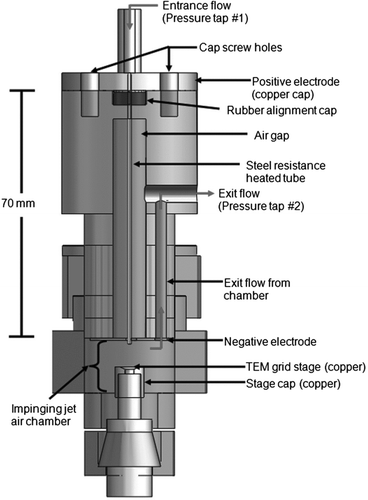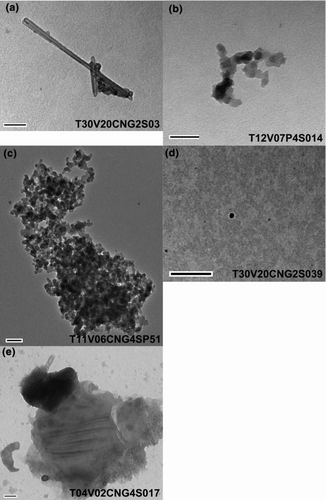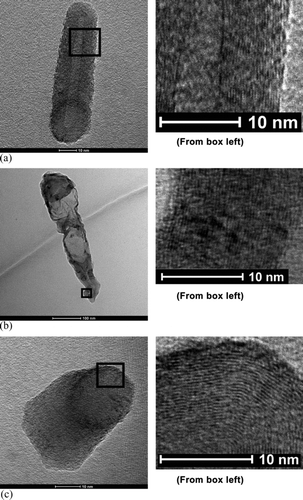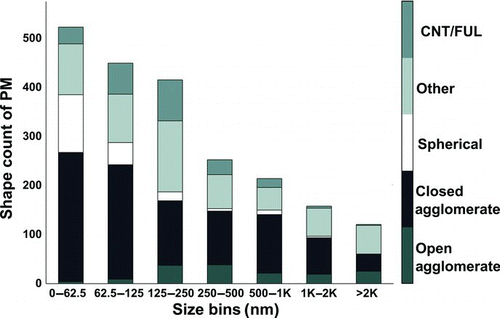Abstract
Particles were collected from the exhaust of Indian autorickshaws with natural gas and gasoline-fueled spark-ignited engines. Transmission electron microscopy was used to determine the size and shape of 2121 systematically selected particles. Particles were largely soot agglomerates and other types documented in the literature, but approximately 10% of the nonvolatile particles were multiwalled carbon nanotubes and fullerenes, forms of crystalline carbon distinct from soot. Autorickshaw fullerenic particle number emissions can be above 1011 per kg of fuel consumed. The nanotubes identified from the exhaust of autorickshaws average 168 nm in length. This is shorter than those nanotubes of greatest health concern, but given the paucity of toxicological data on carbon nanotubes and fullerenes, the potential environmental abundance from engine sources warrants closer attention. In particular, a broader range of engine types should be considered.
[Supplemental materials are available for this article. Please go to the publisher's online edition of Aerosol Science & Technology to view the online files.]
Copyright 2012 American Association for Aerosol Research
INTRODUCTION
Particulate matter (PM) emitted by motor vehicles represents an established health risk, but the chemical or physical features of PM responsible for toxicity are largely unknown (Englert Citation2004). It is widely believed that motor vehicle PM is composed almost exclusively of solid soot, traces of ash and metals, sulfates, and semivolatile organics (Kittelson Citation1998). There is relatively little research on PM from spark-ignited (SI) engines because SI engines emit far less PM than diesel engines (Chakrabarty et al. Citation2006; Dallmann and Harley Citation2010). However, SI engines, especially poorly maintained ones, can produce substantial PM emissions (Mazzoleni et al. Citation2004) and may contribute disproportionately to urban PM exposures (Wu et al. Citation2009). Here, we show that SI engines produce particle types only sparsely reported in the engine emissions literature, including capped carbon nanotubes (CNTs) and closed-shell fullerenes (FULs).
CNTs and FULs were discovered approximately 20 years ago (Kroto et al. Citation1985; Iijima Citation1991) and are of great current interest because of their useful mechanical, thermal, electrical, and chemical characteristics (Baughman et al. Citation2002). However, concern has been raised about the impacts of potential occupational and environmental exposure to CNTs (Lam et al. Citation2006). A number of in vitro and in vivo toxicological studies show that CNTs longer than 10–15 microns may cause lung damage analogous to that caused by asbestos fibers (Donaldson et al. Citation2010). Toxicological studies have shown that, like soot nanoparticles, inhaled submicron CNTs are transported throughout the lungs and can have toxic effects in animals (Muller et al. Citation2005; Oberdörster et al. Citation2005). CNTs/FULs (long or short) have been detected in ambient air (Murr and Garza Citation2009), but their abundance has not been quantified.
Intentional synthesis of CNTs using laboratory flames has been demonstrated, especially with the aid of metal catalyst particles (Hafner et al. Citation1998; Jander and Wagner Citation2006; Wen et al. Citation2008). Emission factors for CNT/FULs from common combustion sources have not been published to our knowledge, though these morphologies have been identified in exhaust from natural gas (NG) stoves (Murr et al. Citation2004) and tentatively from a diesel engine (Evelyn et al. Citation2003) and gasoline engines (Ortner et al. Citation1998). Blom et al. (Citation2000) found structures that might have been FULs but were not identified as such by those authors.
PM samples for this study are from a subset of vehicles tested as part of the Indian Autorickshaw Project (IARP) conducted by the University of British Columbia. IARP measured emissions from compressed NG (CNG) and gasoline-fueled autorickshaws. Autorickshaws are 3-wheeled taxis with single-cylinder SI engines and are a common type of motor vehicle in India and other parts of Asia, as well as in Africa and Latin America. In Delhi, these vehicles are exclusively powered by CNG after the Indian Supreme Court ruled that all public transportation vehicles (buses, taxis, and autorickshaws) must switch to CNG. Most autorickshaws use SI engines and many are also capable of running on gasoline, which offered an opportunity to test them in both fueling modes. IARP was designed to assess fuel switching and technology policy options and is described elsewhere (Reynolds, Grieshop, et al. Citation2011; Reynolds, Kandlikar, et al. Citation2011). Here, we focus on the results from sampling PM and characterizing nonvolatile particle morphology.
VEHICLES AND SAMPLING METHODS
Emission tests were conducted on thirty CNG-fueled 3-wheeled autorickshaws with carbureted 2- or 4-stroke SI engines with engine displacements of 145 and 175 cm3, respectively. Details of the vehicles, engines, and emissions testing protocol can be found in Reynolds, Grieshop, et al. (Citation2011). A subset of the 4-stroke vehicles was equipped with back-up gasoline fuel systems and was also tested operating on gasoline. Vehicles were recruited from the in-use fleet in Delhi and tested on a chassis dynamometer at the International Centre for Automotive Technology (ICAT) in Haryana, India (www.icat.in). Full tests on the Indian Drive Cycle (IDC) allowed measurement of emission factors for gaseous pollutants (CO2, CH4, NOX, THC, and CO) and fine PM [PM2.5 and organic carbon (OC) and elemental carbon (EC) components]. Full-flow dilution of vehicle exhaust via a constant volume sampler (CVS) resulted in test-average dilution ratios between 15 and 40 and sample collection at ambient temperatures (23 ± 2°C). The IDC, used for regulatory testing of Indian vehicles, consists of six 108-s subcycles and runs the vehicle through a range of realistic operating conditions (). Vehicles were tested with the lubrication oil and state of tuning as received to reflect in-use conditions. Further details on sampling methods and vehicle recruitment are published in a related paper (Reynolds, Grieshop, et al. Citation2011) and emissions for the thirty-vehicle set are summarized in Online Supplemental Information (OSI) Part A.
FIG. 1 The IDC. The IDC is used for regulatory emission testing of light-duty vehicles in India. TPS sampling occurred during the acceleration between 0 and 12 m/s in either the 2nd or 3rd subcycle, as indicated by the bold line.
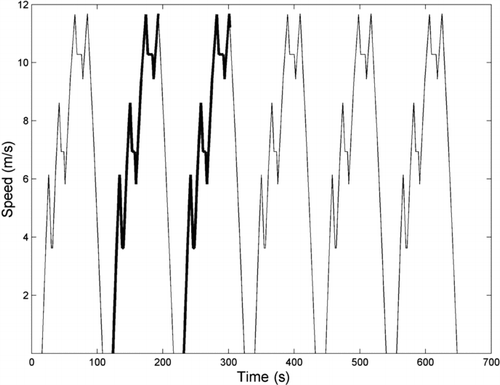
Thermophoretic sampling (TPS) was used to collect particles on transmission electron microscope (TEM) grids from a slipstream of the CVS dilution tunnel. TPS samples were collected over a sampling period of between 10 and 60 s during an acceleration portion of the IDC. Due to the unknown delay between engine-out emissions and TPS sampling, it is impossible to establish the precise engine operating condition (i.e., engine RPM, load) corresponding to the TPS samples. Also, acceleration occurs at slightly different times depending on the driver's ability to follow the ideal IDC test parameters and driver's variation in gear shifting time. However, the acceleration time period was long enough (greater than 20 s) to ensure that TEM grid loading occurred during acceleration of the vehicle.
The TPS draws 0.2–0.3 L/min of sample flow through a 70-mm long heated tube (). The air is heated to approximately 200°C before it impinges as a laminar jet onto the TEM grid held at room temperature. Particle deposits are always higher at the stagnation point (where the heat transfer coefficient is highest). By imaging regions of the grid away from the stagnation point, where the distance between particles is much greater than the particle diameter, we virtually eliminate the possibility of creating artificial agglomerates on the grid. This device has been used extensively for compression-ignition engine exhaust sampling (Soewono and Rogak Citation2011) and is similar in principle to that used by Rogak et al. (Citation1993). In an earlier study of engine soot using the same TPS, it was found that particle projected area equivalent diameter measurements from the TPS/TEM method were within 5% of the mobility diameter (Soewono and Rogak Citation2011).
TPS samples were collected on 3-mm copper grids (Ted Pella, Inc. Prod. No. 01813-F) covered with amorphous carbon film of 30–50 nm thickness. Thirteen TEM grids were analyzed with a Hitachi H7600 TEM. Although this instrument has subnanometer resolution, in practice, particles below about 10 nm are often missed by the human operator given the particle selection process described below. High-resolution images were obtained with a FEI Tecnai G2 TEM at 200 kV.
TEM grids were surveyed starting from 9 evenly spaced positions on the grids to avoid the possibility that the TEM operator would select only the “interesting” particles. At each position, 1 grid square was surveyed along the diagonal. Approximately 10 images were taken for each grid square. Scans across the grid squares used the same magnification for all points (usually at 40 × 103 to 80 × 103 depending on the focus depth required). However, additionally magnified images were taken for particles if necessary for clarity or focus; these imaged particles were not double-counted when more than 1 image was taken.
Particles in over 1200 images were analyzed with the aid of a MATLAB program to find the greatest length (L) and width (W) and subsequently the root mean squared (RMS) of the length and width for each particle. A total of 2121 particles were imaged and classified into the following categories: CNT/FUL, open agglomerates, closed agglomerate, spherical, and “other” (for otherwise unclassified particles). Examples from these categories are shown in . Open access to the online image database from this study is available, according to the directions in OSI Part B.
RESULTS
Fuel-Specific Emissions
For each vehicle tested, fuel-based emission factors were determined for gaseous pollutants, PM2.5, OC, and EC (Reynolds, Grieshop, et al. Citation2011). gives emission factors for the subselection of vehicles for which TPS/TEM sampling and analysis were conducted. These vehicles include 6 with 4-stroke engines running on CNG, 4 with 4-stroke engines running on gasoline, and 3 with CNG 2-stroke engines. EC emissions were very low for the 2-stroke vehicles. However, substantial numbers of solid carbon particles were observed on the TEM grids for these vehicles. The apparent lack of EC on the quartz filter samples may be an artifact of the OC/EC analysis methodology, which was conducted using a modified version of the NIOSH 5040 thermal-optical transmittance protocol in a Sunset Laboratory OC/EC Analyzer (Subramanian et al. Citation2004). The much greater proportion of organic matter may compromise the instrument's ability to distinguish smaller amounts of EC due to OC charring.
TABLE 1 Emissions for vehicles with TPS sampling included
The variation in emissions between vehicles () is striking. Not only do absolute emissions of CO and NOX vary by more than a factor of 4 but also the ratio of CO/NOX is also highly variable, suggesting that fuel/air ratio varies among vehicles. Examination of time-resolved NOX and CO emissions (not shown) shows large variations in this ratio for a single vehicle along the IDC. This makes it very difficult to associate particle morphology with particular engine operating regimes.
IDENTIFYING CARBON NANOTUBE/FULLERENIC PARTICLES
Particles were placed in the CNT/FUL category based on several lines of evidence. First, energy dispersive X-ray (EDX) analysis showed that the particles are carbon with only traces of metals (calcium and iron being most prevalent) or oxygen. Second, particles were stable under the electron beam in a vacuum. Third, the nanotube and FUL morphologies reported in the literature were observed in our samples. Finally, high-resolution TEM (HRTEM) of a subset of the samples showed the expected wall structures of CNT and FULs (Ajayan Citation1999). These lines of evidence are discussed further below.
The autorickshaw CNTs appeared as tubes with a wide range of length/width ratios; the median (followed by range 25th–75th percentile) aspect ratio was 4.83 (5.5–7.6). CNTs were found in samples from all engines and fuel types (). Most of the particles in the CNT/FUL category had structures similar to CNT/FUL particles reported previously (Ajayan Citation1999; Kadish and Ruoff Citation2000). For example, we observed cones with a vertex angle of ≈19° [1 of the 5 possible fullerenic cone angles (Ge and Sattler Citation1994)], large tangled balls, and bent tubes (; Hafner et al. Citation1998). About 24% of the particles in the CNT/FUL category had morphologies that had not been previously reported as FULs (). EDX showed them to be primarily carbon and extremely stable under the intense EDX electron beam. Due to their unusual morphologies, these particles were not included in calculations for CNT length. HRTEM () confirmed the existence of multiwalled carbon structures with d-spacing of 0.34 ± 0.03 nm consistent with sp2 atomic bonding of multiwalled CNT (MWCNTs) or FULs (Iijima Citation1991; Ajayan Citation1999).
FIG. 4 CNTs and nanotube agglomerates from 3 different fuel–engine combinations: CNG/4-stroke (a and b); gasoline/4-stroke (c and d); CNG/2-stroke (e and f). All scale bars are 100 nm.
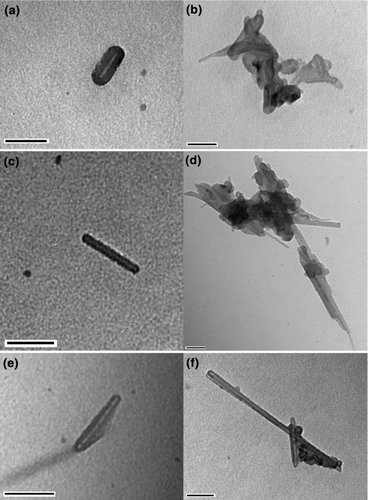
FIG. 5 FULs and CNT types: fullerenic cones with tip angles of approximately 19° from separate 2-stroke engines (a and b); string-like, long CNTs (c and d); jointed CNTs from CNG/2-stroke engines and gasoline/4-stroke engines, respectively (e and f). Scale bars represent 100 nm.

FIG. 6 Examples of particles were categorized as CNT/FUL but without the expected features (such as a hollow core) of FULs or CNT. Scale bars are 500 nm.
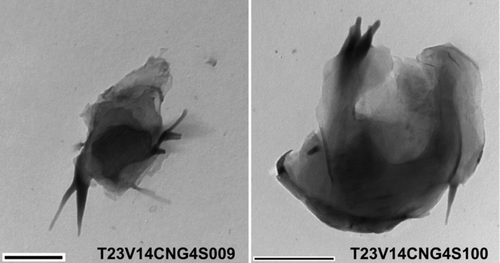
Of the 2121 particles imaged, 234 particles (11% of total) fit best in the CNT/FUL category, of which 178 (8.4% of total) were identified as “classical” nanotube or CNT/FUL shapes reported previously in the literature. The frequency of CNT/FUL varied among the fuel/engine types, but these differences could not be attributed to specific technologies, fuels, or operating conditions (OSI Part C). summarizes particle counts by morphology category and size for all thirteen vehicle tests. For the whole test set, our best estimate of the CNT/FUL proportion for the Indian autorickshaws emissions is 10% ± 7% of the nonvolatile particles. The median length of the nanotubes was 168 nm (98–262 nm). This is much shorter than laboratory synthesized CNTs. The shorter length may result from the short engine residence time (2–20 ms at high temperature) compared with more than 100 ms required to produce closed-shell FULs and tubes from a flame source (Grieco et al. Citation2000).
DISCUSSION
Possibility of Sampling Artifacts
When using TEM grids with amorphous carbon films, there is the risk of contamination from CNTs and FULs formed during the electrodeposition manufacturing process of the grid film. Klie et al. (Citation2004) confirmed previous observations by Harris (Citation2001) that grids with amorphous carbon films can contain contaminant FULs. Through surveys of 3 types of TEM films, Klie et al. determined that about 3 CNT or FUL particles could occur per grid square. To estimate the importance of contamination, we have extrapolated our observed CNT/FUL counts to the entire area of a grid square. For example, lists the counts and interrogated area fractions for a particular vehicle (test T07). The 9 grid squares contain an estimated 2200 CNT/FUL particles, while the expected number of contaminant particles (based on Klie et al. (Citation2004)) is only twenty-seven.
We have repeated this analysis for other grids, and for all cases, the estimated number of CNTs is 10–100 times higher than the expected contamination. As an alternative assessment of contamination, we have polled several microscopists and the grid suppliers (collectively having ∼50 person-years of TEM experience): none had ever observed contaminant CNT or FULs.
Future studies using prescreened grids or carbon-free TEM grids would be useful. Some samples collected from our laboratory NG–SI engine on silicon monoxide film TEM grids show significant numbers of small CNTs coming from the engine (Lagally Citation2011).
ESTIMATES OF FUEL-SPECIFIC CNT/FUL EMISSIONS
We estimated vehicle CNT/FUL emission rates, E CNT (#/kg fuel), using their relative abundance on the microscope grids, N CNT (#/unit area of grid), EC emissions, E EC (g/kg fuel), and estimated volume of EC on the grid, V EC. That is,
TABLE 2 Estimates of total grid square CNT/FUL counts for IARP Test 07
To use EquationEquation (1), it is also necessary to assume that the particles collected during the TPS sampling are representative of the entire drive cycle (for which E EC is determined). This assumption can be partially tested by using time-resolved measurements of PM2.5, CO2, CO, and hydrocarbons to estimate the PM emissions (per unit of fuel) for the acceleration portion of the IDC and the full IDC (Reynolds, Grieshop, et al. Citation2011). These indicate that the ratio of the PM emissions (acceleration/ full IDC) is 1.08 ± 0.4.
Considering the difficulties in estimating V EC, CNT/FUL emission factors could be as high as 1012 per kg fuel but are more likely on the order of 1011 per kg fuel. Previous measurements in vehicle tunnels and other traffic-dominated sites indicate that particle number emissions range from 4 × 1014 to 4 × 1016 particles per kg of fuel burned (Kittelson et al. Citation2004, Citation2005; Ban-Weiss et al. Citation2009). These estimates are for total particle counts (including semivolatile sulfuric acid and organic particles), whereas ours include only the nonvolatile particles corresponding roughly with EC. For comparison, the proposed Euro 5/6 standards for new light commercial diesel vehicles is 6 × 1011 per km, which translates to 60 × 1011 per kg of fuel using a 0.1 kg/km average fuel consumption (typical for a passenger car). This is higher than likely CNT number emissions, but if number standards are applied to SI engines, it could become important to quantify CNT emissions carefully.
ARE AUTORICKSHAWS THE ONLY VEHICLES PRODUCING CNT/FUL?
The ubiquity of CNT/FUL particles in our samples is striking: they were found on eleven of thirteen grids imaged. The present study included only Indian autorickshaws, but it is natural to consider the possibility that other engine types emit CNT/FUL. The autorickshaw engines tested use the same (albeit simpler) technology found in automotive engines worldwide and were in varying states of repair (their conventional PM mass emission rates varied by over an order of magnitude). Considering this, it is unlikely that CNT/FUL emissions are a unique feature of Indian autorickshaws.
So, why are there not more reports of CNT and FUL emissions from engines? TEM is the only method available to identify CNT/FUL particles and to differentiate them from soot or other prevalent particles in an aerosol mixture, and microscopy is a laborious technique. There are very few studies of SI engine emissions using TEM. Diesel exhaust particles have been examined using TEM by hundreds of researchers, but CNTs/FULs are likely rare in diesel exhaust because laboratory studies show that flame conditions leading to soot are less favorable for CNT growth (Height et al. Citation2004). Few studies (of diesel or gasoline engines) have examined more than several hundred aggregates, so rare CNT/FUL might be dismissed as contamination. After finding the CNT/FUL particles in autorickshaw emissions, we reanalyzed TPS/TEM images from an earlier study of diesel and NG compression-ignition engines (Soewono and Rogak Citation2011). Review of 600 images from that study (which used the same sampling methods as used in the present work) yielded only 3 possible FULs with the characteristic hollow core. Prior work has shown that compression-ignition engine emissions are dominated by soot particles (Grieco et al. Citation2000) but may contain a small number of CNT structures (Evelyn et al. Citation2003).
CNTs have been noted in only a few studies of particles sampled from the ambient air (Murr et al. Citation2004; Murr and Garza Citation2009). However, after emission, CNTs may combine with larger ambient particles, and thereby escape identification or be misidentified as mineral fibers. Given the difficulty of their detection and the sparseness of TEM studies, CNT/FUL particles might contribute more than 1% of the ambient nonvolatile particle count and still have escaped widespread recognition. This is not an extrapolation of our study to the whole atmosphere but instead a plausible upper bound given typical atmospheric study methods. It must be stressed that insufficient data exist to make reliable estimates of regional emissions or atmospheric concentrations.
CONCLUSION
Our finding that Indian SI autorickshaw engines can produce significant quantities of CNTs and FULs suggests that these particles may be more prevalent in ambient air than previously believed, and may have always contributed to the health impacts detected by epidemiological studies of air pollution. Hence, future studies to explore the population health effects of CNT/FUL will require measurement of the prevalence of CNT/FUL using laborious microscopy with a focus on particles with the characteristics of combustion byproducts rather than intentionally synthesized materials.
uast_a_617399_sup_21296726.zip
Download Zip (2.8 MB)Acknowledgments
The authors are grateful to the UBC Bioimaging Lab, Dr. A. Nojah and P. Yaghoobi for aid in high-resolution TEM interpretation and to D. Boland for his emissions data processing. Funding was provided by the Natural Sciences and Engineering Research Council of Canada, the BC Environmental and Occupational Health Research Network, and the AUTO21 Network of Centres of Excellence.
REFERENCES
- Ajayan , P. M. 1999 . Nanotubes from Carbon . Chem. Rev. , 99 ( 7 ) : 1787 – 1800 .
- Andreae , M. O. and Gelencsér , A. 2006 . Black Carbon or Brown Carbon? The Nature of Light-Absorbing Carbonaceous Aerosols . Atmos. Chem. Phys. , 6 ( 10 ) : 3131 – 3148 .
- Ban-Weiss , G. A. , Lunden , M. M. , Kirchstetter , T. W. and Harley , R. A. 2009 . Measurement of Black Carbon and Particle Number Emission Factors from Individual Heavy-Duty Trucks . Environ. Sci. Technol. , 43 ( 5 ) : 1419 – 1424 .
- Baughman , R. H. , Zakhidov , A. A. and de Heer , W. A. 2002 . Carbon Nanotubes—The Route Toward Applications . Science , 297 ( 5582 ) : 787 – 792 .
- Blom , A. , Nolan , T. , Storey , J. and Whitney , K. 2000 . “ Characterization of Exhaust Emission Particulate Matter by Transmission Electron Microscopy ” . Paper presented at the 6th Diesel Engine Emission Reduction Workshop 2000, San Diego, California, August 20–24. www.osti.gov/bridge/purl.cover.jsp;jsessionid=9A0A449401CF08FF8DF3856239AFF3C7?purl=/827863-JeNKoY/native/
- Chakrabarty , R. K. , Moosmüller , H. , Arnott , W. P. , Garro , M. A. and Walker , J. 2006 . Structural and Fractal Properties of Particles Emitted from Spark Ignition Engines . Environ. Sci. Technol. , 40 ( 21 ) : 6647 – 6654 .
- Dallmann , T. R. and Harley , R. A. 2010 . Evaluation of Mobile Source Emission Trends in the United States . J. Geophys. Res. , 115 : D14305
- Donaldson , K. , Murphy , F. A. , Duffin , R. and Poland , C. A. 2010 . Asbestos, Carbon Nanotubes and the Pleural Mesothelium: A Review of the Hypothesis Regarding the Role of Long Fibre Retention in the Parietal Pleura, Inflammation and Mesothelioma . Part. Fibre. Toxicol. , 7 : 5
- Englert , N. 2004 . Fine Particles and Human Health—A Review of Epidemiological Studies . Toxicol. Lett. , 149 ( 1–3 ) : 235 – 242 .
- Evelyn , A. , Mannick , S. and Sermon , P. A. 2003 . Unusual Carbon-Based Nanofibers and Chains among Diesel-Emitted Particles . Nano Lett. , 3 ( 1 ) : 63 – 64 .
- Ge , M. and Sattler , K. 1994 . Observation of Fullerene Cones . Chem. Phys. Lett. , 220 ( 3–5 ) : 192 – 196 .
- Grieco , W. J. , Howard , J. B. , Rainey , L. C. and Vander Sande , J. B. 2000 . Fullerenic Carbon in Combustion-Generated Soot . Carbon , 38 ( 4 ) : 597 – 614 .
- Hafner , J. H. , Bronikowski , M. J. , Azamian , B. R. , Nikolaev , P. , Rinzler , A. G. , Colbert , D. T. , Smith , K. A. and Smalley , R. E. 1998 . Catalytic Growth of Single-Wall Carbon Nanotubes from Metal Particles . Chem. Phys. Lett. , 296 ( 1–2 ) : 195 – 202 .
- Harris , P. J. F. 2001 . Carbonaceous Contaminants on Support Films for Transmission Electron Microscopy . Carbon , 39 ( 6 ) : 909 – 913 .
- Height , M. J. , Howard , J. B. , Tester , J. W. and Vander Sande , J. B. 2004 . Flame Synthesis of Single-Walled Carbon Nanotubes . Carbon , 42 ( 11 ) : 2295 – 2307 .
- Iijima , S. 1991 . Helical Microtubules of Graphitic Carbon . Nature , 354 ( 6348 ) : 56 – 58 .
- Jander , H. and Wagner , H. G. 2006 . Formation of Flame Ions, Clusters, Nanotubes, and Soot in Hydrocarbon Flames . Combust. Explos. Shock Waves , 42 ( 6 ) : 696 – 701 .
- Kadish , K. M. and Ruoff , R. S. 2000 . Fullerenes: Chemistry, Physics, and Technology , Wiley-IEEE, New York .
- Kittelson , D. B. 1998 . Engines and Nanoparticles: A Review . J. Aerosol Sci. , 29 ( 5–6 ) : 575 – 588 .
- Kittelson , D. B. , Watts , W. F. and Johnson , J. P. 2004 . Nanoparticle Emissions on Minnesota Highways . Atmos. Environ. , 38 ( 1 ) : 9 – 19 .
- Kittelson , D. , Watts , W. , Johnson , J. , Schauer , J. and Lawson , D. 2006 . On-Road and Laboratory Evaluation of Combustion Aerosols—Part 2: Summary of Spark Ignition Engine Results . J. Aerosol Sci. , 37 ( 8 ) : 931 – 949 .
- Klie , R. , Ciuparu , D. , Pfefferle , L. and Zhu , Y. 2004 . Multi-Walled Carbon Nanotubes on Amorphous Carbon Films . Carbon , 42 ( 10 ) : 1953 – 1957 .
- Kroto , H. W. , Heath , J. R. , O’Brien , S. C. , Curl , R. F. and Smalley , R. E. 1985 . C60: Buckminsterfullerene . Nature , 318 ( 6042 ) : 162 – 163 .
- Lagally , C. D. 2011 . A Morphological Survey of Particulate Matter Emissions from Spark-Ignited Engines , British Columbia , , Canada : Department of Mechanical Engineering, University of British Columbia . M.A.Sc. thesis. http://hdl.handle.net/2429/33754
- Lam , C. , James , J. T. , McCluskey , R. , Arepalli , S. and Hunter , R. L. 2006 . A Review of Carbon Nanotube Toxicity and Assessment of Potential Occupational and Environmental Health Risks . Crit. Rev. Toxicol. , 36 ( 3 ) : 189 – 217 .
- Mazzoleni , C. , Kuhns , H. D. , Moosmüller , H. , Keislar , R. E. , Barber , P. W. , Robinson , N. F. , Watson , J. G. and Nikolic , D. 2004 . On-Road Vehicle Particulate Matter and Gaseous Emission Distributions in Las Vegas, Nevada, Compared with Other Areas . J. Air Waste Manag. Assoc. , 54 ( 6 ) : 711 – 726 .
- Muller , J. , Huaux , F. , Moreau , N. , Misson , P. , Heilier , J. , Delos , M. , Arras , M. , Fonseca , A. , Nagy , J. B. and Lison , D. 2005 . Respiratory Toxicity of Multi-Wall Carbon Nanotubes . Toxicol. Appl. Pharmacol. , 207 ( 3 ) : 221 – 231 .
- Murr , L. , Bang , J. , Esquivel , E. , Guerrero , P. and Lopez , D. 2004 . Carbon Nanotubes, Nanocrystal Forms, and Complex Nanoparticle Aggregates in Common Fuel-Gas Combustion Sources and the Ambient Air . J. Nanopart. Res. , 6 ( 2/3 ) : 241 – 251 .
- Murr , L. and Garza , K. 2009 . Natural and Anthropogenic Environmental Nanoparticulates: Their Microstructural Characterization and Respiratory Health Implications . Atmos. Environ. , 43 ( 17 ) : 2683 – 2692 .
- Oberdörster , G. , Oberdörster , E. and Oberdörster , J. 2005 . Nanotoxicology: An Emerging Discipline Evolving from Studies of Ultrafine Particles . Environ. Health Perspect. , 113 ( 7 ) : 823 – 839 .
- Ortner , H. M. , Hoffmann , P. , Weinbruch , S. , Stadermann , F. J. and Wentzel , M. 1998 . Chemical Characterization of Environmental and Industrial Particulate Samples . Analyst , 123 ( 5 ) : 833 – 842 .
- Reynolds , C. C. O. , Grieshop , A. P. and Kandlikar , M. 2011 . Climate and Health Relevant Emissions from In-Use Indian Three-Wheelers Fueled by Natural Gas and Gasoline . Environ. Sci. Technol. , 45 ( 6 ) : 2406 – 2412 .
- Reynolds , C. C. O. , Kandlikar , M. and Badami , M. G. 2011 . Determinants of PM and GHG Emissions from Natural Gas-Fueled Auto-Rickshaws in Delhi . Transport. Res. D-Tr E , 16 ( 2 ) : 160 – 165 .
- Rogak , S. N. , Flagan , R. C. and Nguyen , H. V. 1993 . The Mobility and Structure of Aerosol Agglomerates . Aerosol Sci. Technol. , 18 ( 1 ) : 25
- Soewono , A. and Rogak , S. N. 2011 . Morphology and Raman Spectra of Engine-Emitted Particulates . Aerosol Sci. Technol. , 45 ( 10 ) : 1206 – 1216 .
- Subramanian , R. , Khlystov , A. Y. , Cabada , J. C. and Robinson , A. L. 2004 . Positive and Negative Artifacts in Particulate Organic Carbon Measurements with Denuded and Undenuded Sampler Configurations: Special Issue of Aerosol Science and Technology on Findings from the Fine Particulate Matter Supersites Program . Aerosol Sci. Technol. , 38 ( 12 suppl 1 ) : 27
- Wen , J. Z. , Richter , H. , Green , W. , Howard , J. , Treska , M. , Jardim , P. and Vander Sande , J. B. 2008 . Experimental Study of Catalyst Nanoparticle and Single Walled Carbonnanotube Formation in a Controlled Premixed Combustion . J. Mater. Chem. , 18 : 1561 – 1569 .
- Wu , J. , Houston , D. , Lurmann , F. , Ong , P. and Winer , A. 2009 . Exposure of PM2.5 and EC from Diesel and Gasoline Vehicles in Communities Near the Ports of Los Angeles and Long Beach, California . Atmos. Environ. , 43 ( 12 ) : 1962 – 1971 .
